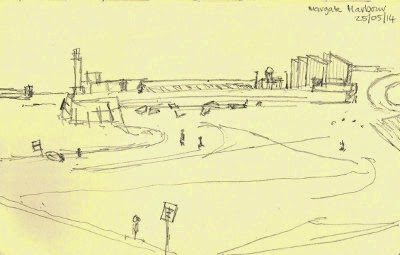 |
| Margate Harbour with the Turner Contemporary - the pointy building on the right hand side ©Heather James |
JMW Turner was a frequent visitor to Margate in the 1820s and '30s and the Turner Contemporary Gallery which opened in 2011 (designed by David Chipperfield Architects) is located on the site where Turner used to stay.
The gallery shows a changing programme of exhibitions and the theme being explored now is 'Summer of Colour'. This includes an exhibition of Piet Mondrian's painting ranging from work completed in his twenties right through to his famous 'grid' paintings in red, yellow and blue and visiting this exhibition was our reason for visiting Margate.
As someone who has been a fan of Mondrian since being introduced to his work during an art history lesson aged 16 I was very excited at the prospect of seeing some of his work close up and I was not disappointed. There are about 50 works on show which means there are enough examples of his paintings to see how his work developed towards abstraction through colour but not so many that you feel overwhelmed. I particularly liked 'Dune Landscape, (July-September) '1911 and 'The Red Mill' 1911.
In addition to this there is an exhibition by Spencer Finch, an American artist, who attempts to make visible the fleeting nature of natural phenomena and it includes a suspended sculpture that subtly alters as the natural light in the gallery changes throughout the day. It is worth being patient by staying in the gallery long enough to observe the changing light in order to really appreciate his work.
We stayed in Margate overnight so we had the chance to visit these exhibitions on two consecutive days. In addition to enjoying the gallery we were also able to have a look at Margate train station on our arrival and departure and note that it was designed in 1926 along with Ramsgate Station and was the first major buildings to be designed by the British Modernist architect Maxwell Fry. Apparently the design was based on Roman thermal baths.
Another piece of architecture worth looking at is Arlington House which is close to the station and dominates the skyline. It is a 19 storey residential block designed by Russell Diplock and completed in 1964. It's an iconic example of brutalist architecture and sits slightly uncomfortably with the down-at-heel Victorian seaside architecture surrounding it.
We're looking forward to returning to Margate when the exhibitions change in the autumn, trying out some different restaurants and exploring on foot the Isle of Thanet which is the name for this part of north Kent.
Mondrian and Colour: Turner Contemporary Gallery, Margate until 21 September 2014, free admission
